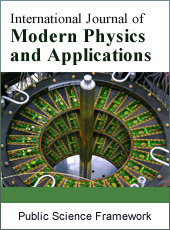International Journal of Modern Physics and Applications
Articles Information
International Journal of Modern Physics and Applications, Vol.1, No.1, Mar. 2015, Pub. Date: Mar. 14, 2015
Algebraic Studies for Electronic Structures and Photodissociation of Bromine Molecule
Pages: 1-5 Views: 5680 Downloads: 1170
[01]
A. Abdel-Hafiez, Department of Experimental Nuclear Physics, Nuclear Research Center, Atomic Energy Authority, Cairo, Egypt.
I have theoretically studied the nonadiabatic transitions among the lower states with =1u symmetry (1u(1) to 1u(3)) in the photodissociation of Br2 using the Comlete Active Space Self-Consistent Field (CASSCF) computations and the time-independent SchrÖdinger equations. The CASSCF wave function is formed from a complete distribution of a number of active electrons in a set of active orbitals, which in general constitute a subset of the total occupied space. From the configuration analysis of the CASSCF wavefunctions, we found that the nonadiabatic transition between 1u(2) and 1u(1) is a noncrossing type, while that between 1u(2) and B30+u is a crossing type. The spectroscopic constants for the X1g+, A31u and B30+u states of Br2 is calculated. The absorption cross-section for the ground and the lower excited states in the photodissociation of Br2 molecule is presented as well as the numerical estimates of nonadiabatic transition probabilities. Also, the five highest occupied and the five lowest unoccupied orbitals of Br2 have been calculated.
Algebraic technique / Quantum dynamics/ Electronic structure
[01]
T. G. Lindeman and J. R. Wiesenfeld; J. Chem.Phys. Vol. 70, No.6, 1979, 2882]
[02]
Bracker, A. S.; Wouters, E. R.; Suits, A. G.; Vasyutinskii, O. S. J. Chem. Phys. 1999, 110, 6749.
[03]
Alexander, A. J.; Kim, Z. H.; Kandel, S. A.; Zare, R. N.; Rakitzis, T. P.; Asano, Y.; Yabushita, S., J. Chem. Phys. 2000, 113, 9022..
[04]
Rakitzis, T. P.; Kitsopoulos, T. N. J. Chem. Phys. 2002, 116, 9228.
[05]
Bass, M. J.; Brouard, M.; Clark, A. P.; Vallance, C.; Martinez- Haya, B. Phys. Chem. Chem. Phys. 2003, 5, 856.
[06]
Yukako Asano and Satoshi Yabushita, Bull. Korean Chem. Soc. 2003, Vol.24, No. 6, 703.
[07]
Li, J.; Balasubramanian, K. J. Mol. Spectrosc. 1989, 138, 162.
[08]
Teichteil, C.; Pelissier, M. Chem. Phys. 1994, 180, 1.
[09]
de Jong, W. A.; Visscher, L.; Nieuwpoort, W. C. J. Chem. Phys. 1997, 107, 9046.
[10]
Per E.M. Siegbahn; Jan Almlof; Anders Heiberg; Bjorn O. Roos, J. Chem. Phys. 1981, Vol.74, No.4, 2384.
[11]
M. J. Frisch, G. W. Trucks, H. B. Schlegel, G. E. Scuseria, M. A. Robb, et. al, Gaussian 03, Revision B.01, Gaussian, Inc., Pittsburgh PA, 2003.
[12]
J.Paldus, in Theoretical Chemistry: Advances and perspectives, edited by H. Eyring and D. Henderson
[13]
Complete Active Space SCF (CASSCF) and Multiconfiguration SCF (MCSCF) Wavefunctions, by Yukio Yamaguchi, Center for Computational Quantum Chemistry, School of Chemical Sciences, The University of Georgia, Athens, Georgia 30602, spring, 1996.
[14]
Colby Chemistry, Pauel J. Schuef Computational Chemistry Lab. 2005, Holland. http://www.colby.edu.
[15]
Huber, K. P.;Herzberg, G. Constants of Diatomic Molecules: Van Nostrand Reinhold: New York, 1979.
[16]
Coxon, J. A. In Low-lying Electronic States of Diatomic Halogen Molecules; Barrow, R. F.; Long, D. A.; Millen, D. J., Eds.; Molecular Spectroscopy Vol. 1; The Chemical Society: London, 1973; p177
[17]
M.J. Cooper, E. Wrede, A.J. Orr-Ewing, M.N.R. Ashfold, J. Chem. Soc. Faraday Trans. 94 (1998) 2901
[18]
Balint-Kurti, G. G.; Mort, S. P.; Marston, C. C. Comput. Phys. Commun. 1993, 74, 289.
[19]
S. Hubinger, J.B. Nee, J. Photochem. Photobiol. A:Chem.86(1995)1. (Academic, New York, 1976), Vol.2, p. 131.

ISSN Print: 2381-6945
ISSN Online: 2381-6953
Current Issue:
Vol. 7, Issue 1, March Submit a Manuscript Join Editorial Board Join Reviewer Team
ISSN Online: 2381-6953
Current Issue:
Vol. 7, Issue 1, March Submit a Manuscript Join Editorial Board Join Reviewer Team
| About This Journal |
| All Issues |
| Open Access |
| Indexing |
| Payment Information |
| Author Guidelines |
| Review Process |
| Publication Ethics |
| Editorial Board |
| Peer Reviewers |


